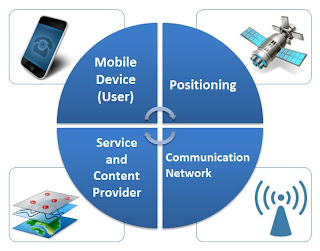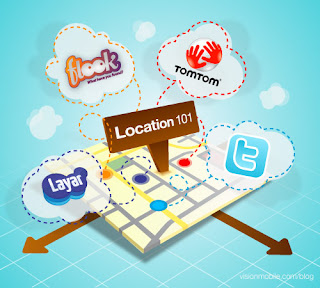 |
| Fig.1. Location Based Services |
In this post I’m summing up a little bit of theory about Location Based Services (LBS) that I will use for my further academic research. In some papers, books and blog posts it is possible to see different terms interchangeably used to describe the same service: location-aware services, location-related services or location services. Nonetheless the term Location Based Services has been already used and acclaimed by most scientific and professional communities.
Location based services – definitions.
Although LBS is a fairly new domain of science one can find several definitions:
“LBSs are information services accessible with mobile devices through the mobile network and utilizing the ability to make use of the location of the mobile device.” [1]
“Location-based Services are IT services for providing information that has been created, compiled, selected, or filtered taking into consideration the current locations of the users or those of other persons or mobile objects.”[2]
So basically LBS are using potential and capabilities of modern mobile devices, positioning technologies and mobile internet to deliver to user value added information or service based on his location. The main value of LBS for users is that they don’t have to enter location information manually but its automatically collected (with positioning technologies) and used to generate personalized information.
 |
Fig.2. LBS as an intersection of technologies
(Brimicombe 2002). |
LBS – intersection of technologies.
LBS is a field that uses achievements of several technologies. Brimicombe in 2002 proposed to present LBS as an intersection of several technologies: Geographical Information Systems (GIS), Internet, and Mobile Devices (or New Information and Communication Technologies). This concept is pretty straightforward and doesn’t need much explanation. The crucial observation is that the technology is actually going in those three directions: information (Internet), mobility (Moble Devices), location (GPS, GIS). According to statistics only in the 4Q of 2010 there where 100.9 million units of smartphone sold. And it was the first time in the history that sales of smartphones was higher than PCs [4]. Moreover already 25% of users prefer using smartphones over a computer to browse the World Wide Web and the number is growing [5]. Conclusions? Decreasing prices of modern mobile devices are pushing
Information Society to go mobile. Now how about location and Geographical Information Systems? People are getting more conscious about the spatial aspect of life. Due to popularity of Google Maps they are already used to certain location-based ideas and their utilization. Maps are in fact one of the first five priorities of Google for the future. Maps are naturally linked with space and for centuries they have been used to find position and to navigate. In the most basic model users where trying to localize themselves on the paper maps and to find their way to targeted place. With the development and release to the public Global Positioning System and first PNDs (Personal Navigation Devices) users started to utilize digital mapping in a mobile way. Therefore it is not a surprise that the most used application on Android and third most used application on iPhone platform is Google Maps. Google recently disclosed that 40% of all Google Map use takes place on mobile phones. There is as well growing number of users of popular Location-Based Social Networks (LBSN). Already well known in USA, LBSNs are gaining popularity in Europe and Asia.
LBS components.
Almost all LBSs are based on components present on the figure 3. All of them create LBS infrastructure and parameters of each of them are crucial for the service to work. Those components are: Service and Content Provider, Mobile Device, Positioning Systems, and Communication Network.
 |
| Fig.3. Basic components of LBS |
Service and Content Provider
These are all companies providing service, data and that are responsible for the service request processing. Those providers are for example Location Based Social Networks or GSM operators.
Mobile Device
These are all non-stationary devices that are tools for the user to request the needed information. For example mobile phones, smartphones, PDAs, tablets, laptops. Those devices can have build-in or external positioning module (e.g. GPS antena).
Positioning System
Positioning of the user is of course the heart of LBS. The user position can be obtained in several ways. The most common two of them are GPS with a several meters accuracy and the mobile communication network which uses one or more cell towers to determine the position of devices with several hundred meters accuracy. The other possibility is to use the position are WLAN stations – there are companies specialized in capturing information about wi-fi location and using it for positioning. This option is possible only in the cities because of need of high network density but it can give surprisingly good accuracy of several dozen meters. Other topic is indoor navigation which can use as well wi-fi or Bluetooth for determining position inside buildings.
Communication Network
The last component is communication network which is responsible for transferring the user data and service request from the mobile device to the service provider and then the requested information back to the user.
References:
1. Virrantaus, K., Markkula, J., Garmash, A., Terziyan, Y.V., 2001. Developing GIS-Supported LocationBased Services. In: Proc. of WGIS’2001 – First International Workshop on Web Geographical Information Systems., Kyoto, Japan. , 423–432.
2. Axel Kupper – “Location-based Services: Fundamentals and Operation”, 2005, John Wiley & Sons Ltd,











